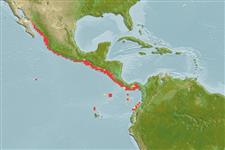Environment: milieu / climate zone / depth range / distribution range
Ökologie
seewasser demersal; standorttreu; tiefenbereich 80 - 523 m (Ref. 58018). Subtropical; 28°N - 1°N, 113°W - 78°W (Ref. 58452)
Eastern Pacific: off the west coast of the Americas from Del Mar, California to Ensenada de Tumaco, Colombia. Vrooman and Paloma's (1970) dwarf hake off the coast of Baja California has recently been described as a different species, Merluccius hernandezi Mathews, 1985.
Length at first maturity / Size / Gewicht / Alter
Maturity: Lm 22.0, range 18 - 27 cm
Max length : 40.0 cm TL Männchen/unbestimmt; (Ref. 1371); common length : 32.0 cm TL Männchen/unbestimmt; (Ref. 1371)
Kurzbeschreibung
Morphologie | Morphometrie
Rückenflossenstacheln (insgesamt): 1; Rückenflossenweichstrahlen (insgesamt): 45-52. Head rather long, about 30% of SL. Gill rakers long and slender, with pointed tips. Pectoral fins long, the tips reaching to or beyond the origin of the anal fin. Overall color silvery, lighter ventrally.
Occurs from shallow continental shelf to the upper continental slope, and in the mid-waters of the open sea and on sea-mounts (Uncle Sam Bank). Exploited only on a local level due to its abundance and its relatively small median size (Ref. 9119). Minimum length of first sexual maturity for both sexes is 18-19 cm, and spawning occurs from April to June, or later (Ref. 58452).
Life cycle and mating behavior
Geschlechtsreife | Fortpflanzung | Ablaichen | Eier | Fecundity | Larven
Cohen, D.M., T. Inada, T. Iwamoto and N. Scialabba, 1990. FAO species catalogue. Vol. 10. Gadiform fishes of the world (Order Gadiformes). An annotated and illustrated catalogue of cods, hakes, grenadiers and other gadiform fishes known to date. FAO Fish. Synop. 125(10). Rome: FAO. 442 p. (Ref. 1371)
IUCN Rote Liste Status (Ref. 130435)
Bedrohung für Menschen
Harmless
Nutzung durch Menschen
Fischereien: weniger kommerziell
Mehr Information
ReferenzenAquakulturAquakultur ProfilZuchtlinienGenetikElectrophoresesVererbbarkeitKrankheitenVerarbeitungNutrientsMass conversion
Tools
Zusatzinformationen
Download XML
Internet Quellen
Estimates based on models
Preferred temperature (Ref.
123201): 11.1 - 13.7, mean 12.6 °C (based on 24 cells).
Phylogenetic diversity index (Ref.
82804): PD
50 = 0.5000 [Uniqueness, from 0.5 = low to 2.0 = high].
Bayesian length-weight: a=0.00447 (0.00243 - 0.00821), b=3.09 (2.93 - 3.25), in cm total length, based on LWR estimates for this Genus-body shape (Ref.
93245).
Trophic level (Ref.
69278): 4.0 ±0.5 se; based on size and trophs of closest relatives
Generation time: 3.3 ( na - na) years. Estimated as median ln(3)/K based on 2
growth studies.
Widerstandsfähigkeit (Ref.
120179): mittel, Verdopplung der Population dauert 1,4 - 4,4 Jahre. (K=0.34-0.35; tm=3; tmax=7).
Fishing Vulnerability (Ref.
59153): Low to moderate vulnerability (33 of 100).
Climate Vulnerability (Ref.
125649): Moderate vulnerability (39 of 100).
Nutrients (Ref.
124155): Calcium = 44.7 [17.6, 138.5] mg/100g; Iron = 0.85 [0.29, 2.18] mg/100g; Protein = 18 [17, 19] %; Omega3 = 0.171 [0.102, 0.286] g/100g; Selenium = 45.8 [20.1, 103.7] μg/100g; VitaminA = 19.9 [5.9, 66.5] μg/100g; Zinc = 0.458 [0.292, 0.702] mg/100g (wet weight);
